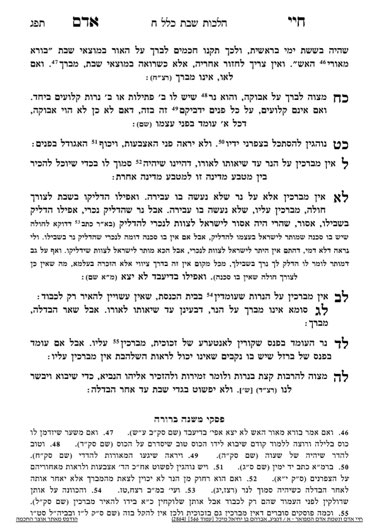BE”H, we will be starting Klal 9 on January 1st. Klal 9 is all of the basic rules of meleches Shabbos, and therefore a very important klal. Sponsorships are available for the whole klal or individual concepts or individual shiurim. Please contact Rabbi Reingold at (301)996-5910 or rabbireingold@gmail.com to sponsor
We are beginning siman 32. There is a minhag to show kavod for a shul by lighting light candles in it (some have a similar minhag at a bris). The Chayei Adam writes that since these candles are lit for kavod, and not I for the purpose of light, one cannot make the bracha of borei meorei haeish on them. The bracha must be made on a neir which is lit for the purpose of illumination and benefit. Practically, many shuls no longer follow the minhag of lighting candles, but a practical application will be that one cannot use a yahrzeit candle as the eish for havdalah, since it is lit as kavod for the niftar and not for light.
Taking the question a step further, now that we have electric light, the neiros we light on Motzei Shabbos going into Yom Tov are primarily for kavod, since illumination is provided via electric light. If so, how can one recite havdalah on those neiros?
Similarly, if a person has the minhag to turn off the electric lights when making havdalah, the neir is producing illumination at the time of the bracha. However, for the many who do not have this minhag, a person may incorrectly view the neir as purely a mitzvah, since they practically do not derive benefit from it. If so, the neir is functioning for kavod and not for benefit, and a person is not yotzei even bedieved.
Regarding Motzei Shabbos going into Yom Tov, we must assume that since the minhag is to light those neiros, a person must be lighting them with the intent of adding candlelit illumination to their Yom Tov meal. Therefore, we can use them for the bracha of neir, since they provide illumination.
Regarding regular havdalah, a person must realize that one of the reasons we are makpid to get closer to the neir and benefit from it (to see one’s fingernails) is to demonstrate the purposefulness of the neir, and that it is not just lit for kavod. If so, it would come out that even according to the opinion that one does not need to practically benefit from the neir, but needs to be close enough that they could potentially derive benefit from the neir (see shiur S249), it is still appropriate to come closer to the neir and make use of it in some way to demonstrate that the purpose of the neir is to derive benefit from it.
In siman 33, the Chayei Adam writes that a blind person can be motzi others in havdalah, but cannot make the bracha of neir nor can he be motzi others in the bracha. Even if neir is a birchas hashevach (see shiur 248), one needs to see the shevach before making the bracha, so a blind person is unable to make the bracha nor be motzi someone else.
Summary
- The bracha of neir must be made on a neir which is for the purpose of benefit, and not just lit for kavod.
- A blind person cannot make the bracha on neir nor be motzi others.



